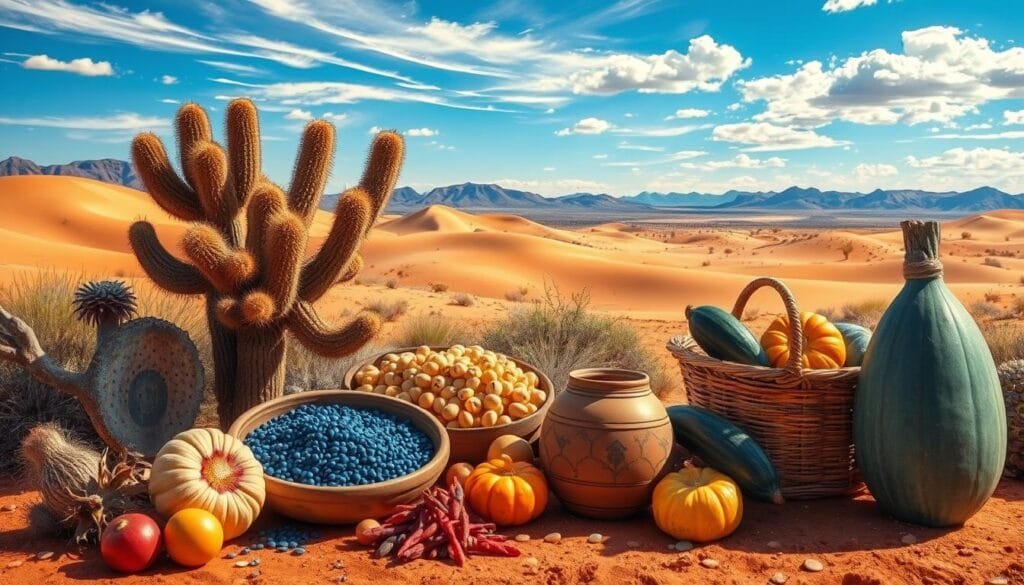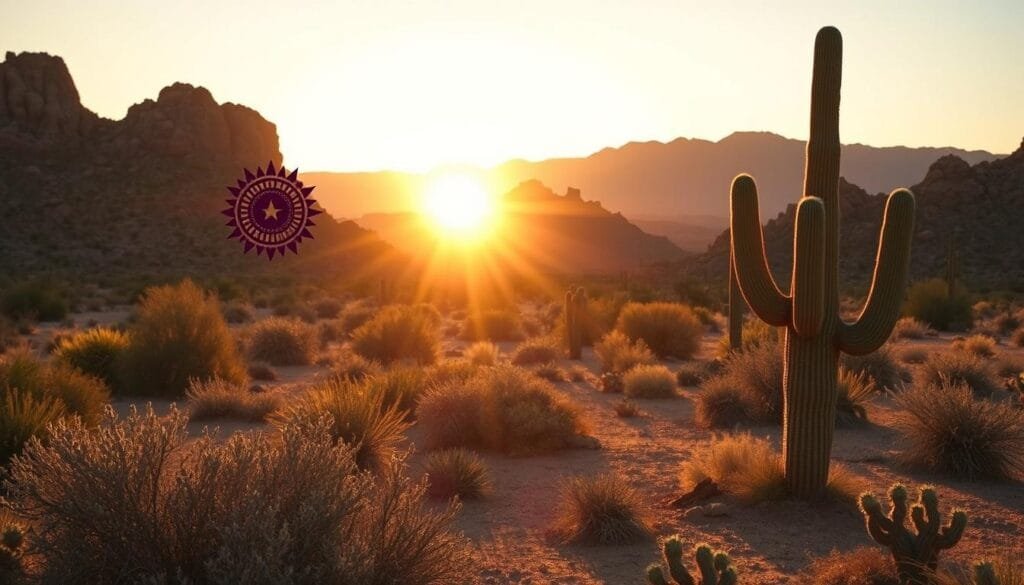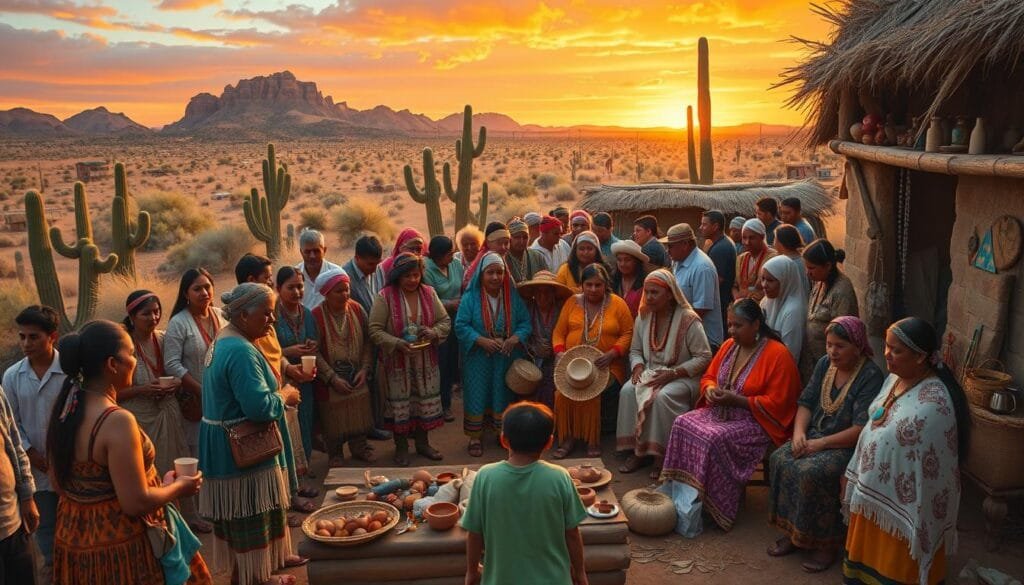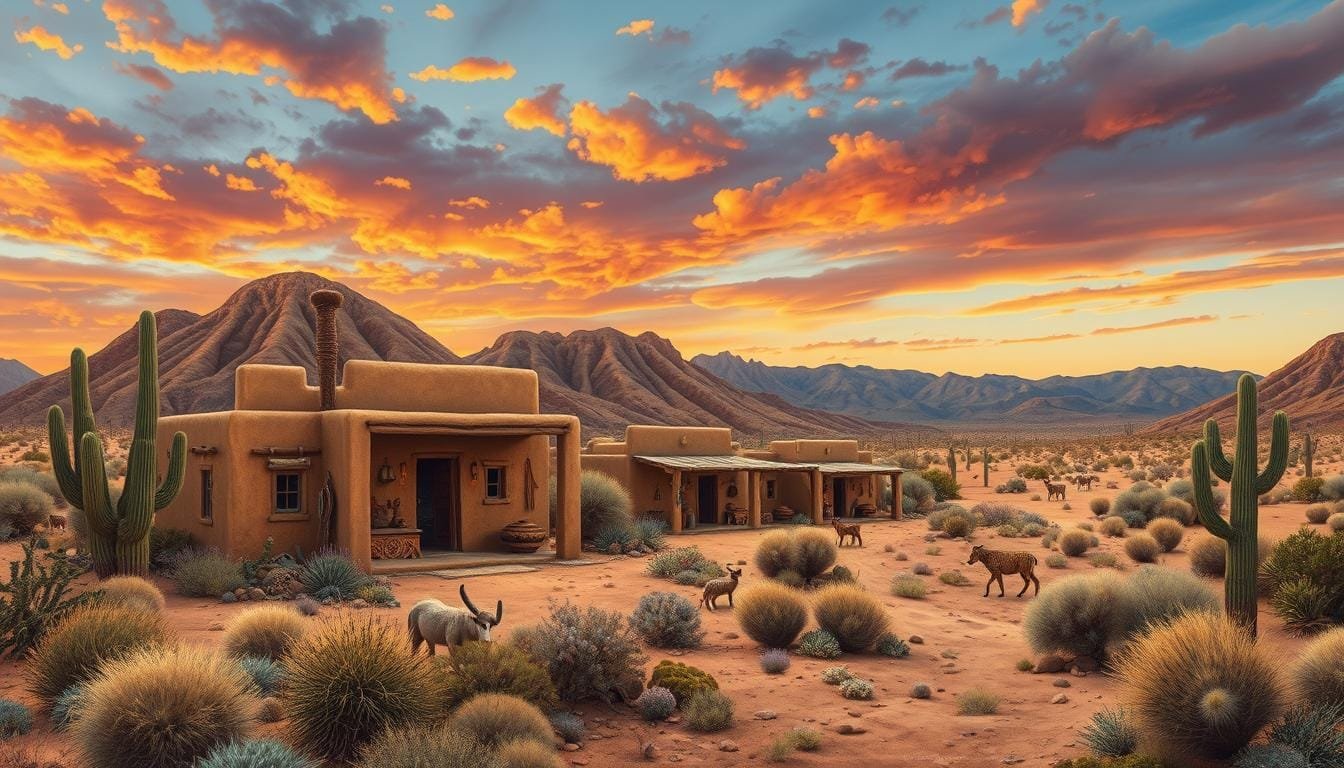Have you ever wondered about communities mixing old ways with new?
The Tohono O’odham Nation thrives in the Sonoran Desert. It stretches over southern Arizona and Sonora, Mexico. This tribe has around 28,000 members. They keep their traditions alive while living on their ancestral lands. Their reservation is huge, almost as big as Connecticut. It’s the second-largest home for Native Americans in the U.S.
Their culture is a special blend of old and new. They grow crops like squash, beans, and corn using traditional floodwater methods. Alongside, they run modern businesses such as Desert Diamond Casinos. They harvest saguaro cacti in summer and enjoy dances with waila music. This music mixes O’odham fiddle, polka, mariachi, norteño, and rock—a true blend of cultures.
Key Takeaways
- The Tohono O’odham Nation consists of approximately 28,000 registered members.
- The Nation covers about 2.8 million acres, making it the second largest reservation in the U.S.
- The Tohono O’odham maintained traditions like floodwater farming and seasonal harvesting.
- Traditional O’odham diet includes cultivated crops and gathered foods such as cactus fruits.
- Waila music reflects a cultural blend of German, Spanish, Mexican, and American influences.
A Brief History of Tohono O’odham
The Tohono O’odham people have a rich history tied to their beginnings and lineage. They are descendants of the Hohokam civilization. This ancient group mastered desert farming in the Sonoran Desert using advanced techniques like acequias. From these beginnings, they evolved into the Tohono O’odham. They skillfully met the challenges of living in the desert’s tough conditions.
The story of the Tohono O’odham includes moving across the land, always in search of water for farming. They settled in the Sonoran Desert. Here, they grew crops such as tepary beans and squash. They were guided by the irrigation knowledge of their Hohokam ancestors. Moving seasonally was key to their way of life and keeping their culture alive.
The San Xavier Mission was built in 1700 by Father Eusebio Kino. This event is a highlight in their story. Later, the Treaty of Guadalupe Hidalgo and the Gadsden Purchase changed their land, especially with the U.S.-Mexico border creation. Yet, the Tohono O’odham kept their traditions strong despite these changes.
In 1917, their main reservation was formed, covering 2.8 million acres. By 1937, they had their first Constitution, a big step in managing their community. They later built their Utility Authority and Community College. These actions show their initiative and unity in preserving their heritage.
The Tohono O’odham have faced many trials, like environmental and political challenges. Still, they’ve shown immense resilience. Their dedication to their traditions and migrations speaks to their strong spirit.
For more details on the historical journey of the Tohono O’odham, visit their official history and culture page.
The Landscape and Diet of the Tohono O’odham
The “Desert People,” or Tohono O’odham, have lived in the Sonoran Desert for centuries. They practiced Traditional Farming, deeply understanding their land. They adapted to the desert by planting with the summer monsoons. This method allowed them to grow crops like tepary beans, 60-day corn, and O’odham squash on thousands of acres.

The Tohono O’odham’s diet comes from the desert around them. Saguaro cactus fruit, for instance, is a key source of calcium. It offers more calcium in two tablespoons than a glass of milk. They also eat cholla buds, mesquite bean pods, and various beans, which are rich in fiber, carbohydrates, and minerals. Cholla buds are especially praised for their high calcium content.
They also hunted and gathered food, which made their diet even healthier. This mix of farming and foraging showed their smart farming methods. It ensured they always had food, despite the desert having very little rainfall.
Originally, the Tohono O’odham only ate natural desert foods, making their bodies very good at using these foods. But the Spanish brought new foods like wheat and beef, which changed their diet. With less access to traditional water sources and more reliance on government food, their health worsened. Today’s diet, full of fats, sugars, and chemicals, led to new health issues for them.
One important part of their diet and culture is the saguaro harvest. It’s a key food source and a sacred ceremony. It connects them to the land and their ancestors.
Spiritual and Cultural Beliefs of the Tohono O’odham
Mythology is key to the Tohono O’odham’s spiritual world. Their beliefs are deeply tied to desert mythology. They think the land and all in it were gifts from Elder Brother. This belief makes their spiritual practices sacred, closely linked to nature.
The Tohono O’odham share their beliefs through cultural ceremonies. These ceremonies are more than religious events. They’re vital to the community, blending spiritual growth with social ties. By joining in these ceremonies, people strengthen their identity and pass on old wisdom.

Their spirituality revolves around the desert. They value every plant and animal, seeing them as part of their spiritual world. This is shown in festivals and ceremonies related to farming, where they perform rituals for good harvests and nature’s balance.
Tohono O’odham’s environmental respect is shown in their customs:
- Seasonal festivals for planting and harvesting.
- Rituals celebrating the seasons and weather changes.
- Ceremonial dances and songs that reflect their myths and beliefs.
Their population trends also underscore their cultural strength:
| Year | Population |
|---|---|
| 1680 | ~6,000 |
| 1990 | 16,876 |
| 2000 | 20,087 |
| 2004 | 25,940 |
Tohono O’odham spirituality and their bond with the land are crucial. Desert mythology helps keep their culture and health alive. Their stories, beliefs, and daily lives merge, helping them prosper today.
What is the Tohono O’odham Culture Like?
The modern Tohono O’odham culture mixes old roots with new influences. It shows how they keep traditions while adapting to new ways. The Tohono O’odham, known as “desert people,” live mainly in Arizona and Sonora, Mexico. They number 29,543 people.

Keeping the O’odham language alive is key to their culture. The Tohono O’odham Community College, started in 2000, teaches this language. Also, KOHN-FM 91.9 Radio, started in 2004, lets them express their culture and use their language.
The Tohono O’odham have blended modern life with their traditions. They officially established their main reservation in 1917. Their first Constitution came in 1937, marking governance and societal progress.
They have embraced new economic and recreational projects without losing their culture. The Tohono O’odham Gaming Enterprise runs three casinos. The Desert Diamond Casino expanded with a hotel in 2007. This shows economic growth. Also, they have five recreation centers that boost community life and show cultural adaptation.
Music plays a big part in their culture, with traditional instruments like hardwood rasps and baskets for drums. Socially, children enjoy freedom until six, then they learn cultural roles. Women handle food and gathering, and men take care of farming and hunting. This reflects a mix of tradition and modern practices.
Table: Tohono O’odham Cultural and Social Aspects
| Aspect | Details |
|---|---|
| Population | 29,543 |
| Main Residence Areas | Arizona, USA; Sonora, Mexico |
| Traditional Music Instruments | Hard wood rasps, overturned baskets |
| Primary Social Norms | Children learn roles at age six; Women handle food preparation, men focus on farming and hunting |
| Educational Initiatives | Tohono O’odham Community College (2000) |
| Media Initiatives | KOHN-FM 91.9 Radio Station (2004) |
| Economic Initiatives | Desert Diamond Casino (2007) |
The Tohono O’odham have wonderfully evolved their societal norms and structures. They mix heritage preservation with new ways to thrive in today’s world. Their strong education and cultural efforts show their resilience and creativity amidst change.
Gender Roles and Daily Life
In the Tohono O’odham community, men and women have specific roles. Women were in charge of cooking, childcare, and making beautiful woven baskets. These baskets show their amazing skill in indigenous craftsmanship. Men took care of farming, hunting, and sometimes fought in wars. Their actions showed cleverness and courage.
The roles of Tohono O’odham gender roles came from understanding their environment and needs. Basket weaving by women was more than making items for daily use. It was also a key cultural activity with spiritual value. The baskets had detailed designs that were symbolic, highlighting their weaving expertise.
Today, life in Tohono O’odham has changed, making gender roles more flexible. Women still share the art of basket weaving, keeping their heritage alive. Men now also take on roles once done by women. This shows a move towards equal work sharing.
Knowing about the traditional roles in Tohono O’odham helps us see how their culture keeps its essential values while adapting. It shows their community’s strength and ability to change. This lets us see the rich culture of their daily life in Tohono O’odham culture.
The O’odham Today
The Tohono O’odham Nation is one of the four major federally recognized tribes in the United States. It covers about 2.8 million acres. That’s nearly as big as Connecticut. This makes it Arizona’s second largest reservation. The Nation has grown a lot over time. It focuses on Indigenous governance and keeping the community strong.
In 1937, the Nation took a huge step by adopting its first Constitution. This was crucial for self-rule. Later, in 1970, the Tohono O’odham Utility Authority was started. Then, in 1979, they opened the Tohono O’odham Career Center. These steps helped improve community dynamics and the economy.
The Tohono O’odham Nation really values education and health. In 1998, it founded the Tohono O’odham Community College which started classes in 2000. This move greatly helped in giving more educational opportunities. The Sells DaVita Dialysis Center and San Simon Health Center, both opened in 2007, show the Nation’s focus on healthcare.
The Nation has a Tribal Council and a Chairperson. They are elected to look after the needs of their people. This is important because their land is huge. They need plans that include everyone. The Tohono O’odham Gaming Enterprise, started in 1983, now has three casinos. This venture has greatly helped their economy.
But, there are still problems. Issues like tribal recognition and the border are big challenges. The Gadsden Purchase in 1854 cut through their land. This split has caused legal and cultural problems. Especially for those who travel between the U.S. and Mexico. The Nation is working to solve these issues. They want to keep their heritage strong while managing Indigenous governance.
The Tohono O’odham’s strength is shown in their traditions and how they face new challenges. They keep their cultural events, like the annual saguaro harvest. At the same time, they work on governance, healthcare, education, and the economy. Their unity and resilience shine through in the Tohono O’odham Nation.
Conclusion
Reflecting on the Tohono O’odham story, we see their incredible strength and presence. This tale shows their deep bond with a huge land, as big as Connecticut. They’ve kept their customs alive despite today’s obstacles.
With nearly 28,000 members, the Tohono O’odham Nation overcomes tough geographical and political issues. One big challenge is the international border cutting through their land. Still, their culture and community spirit stay strong. Their governing body, the Tohono O’odham Council, ensures their traditions shape their laws and modern life.
Learning about the Tohono O’odham enriches our understanding of Native American history. Their story is a vital part of today’s America, worthy of honor and respect. Exploring their culture helps us appreciate all cultures more. It gives us a wider view of our collective human journey.
FAQ
Who are the Tohono O’odham people?
The Tohono O’odham are Indigenous people living in the Sonoran Desert. They come from the Hohokam. The Hohokam were famous for their advanced farming and strong culture.
What is the significance of the Sonoran Desert to the Tohono O’odham?
For the Tohono O’odham, the Sonoran Desert is vital. It shapes their farming, food, beliefs, and traditions. They share a deep bond with the land and its gifts.
How did the Tohono O’odham adapt their farming practices to the desert environment?
The Tohono O’odham mastered desert farming. They grew beans and corn and managed water with acequias. Their smart methods helped them prosper in a dry setting.
What role do myths and spiritual beliefs play in Tohono O’odham culture?
Myths and beliefs are core to their culture. They see the land as sacred, filled with living gifts from Elder Brother. Their rituals and festivals celebrate this spiritual bond.
How has contemporary Tohono O’odham culture evolved?
Today’s Tohono O’odham culture mixes past and present. They embrace new ways while keeping their heritage alive. They work hard to keep their language and traditions going.
What were the traditional gender roles within the Tohono O’odham community?
Women handled the home and food; men did hunting and crafts. These roles have shifted but still honor traditions like basket weaving. This craft holds special meaning.
How is the Tohono O’odham Nation structured today?
The Tohono O’odham Nation controls a large area and governs independently from tribes like the Gila River and Ak-Chin. They focus on unity and self-governance across their land.
What can we learn from the Tohono O’odham culture?
Their culture teaches us about staying strong, being adaptable, and connecting with nature. Studying their ways offers valuable lessons and deepens our respect for their important place in Native American history.
